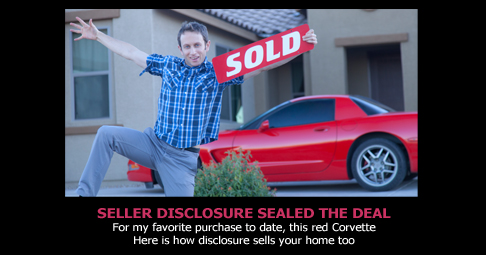Back in 2006 I finished my graduate degree.
It was time to get myself a present, my dream car a FRC Corvette.
This was going to be the biggest purchase of my life at age 25 and I had a LOT of questions.
Salesmen frequently told me they did not know about the Corvettes they were selling.
Some even said, to make an offer then they would tell me about the car’s history.
Finally I called on a personal ad for a guy selling his Corvette in Detroit. The guy spent time addressing all my answers.
He even had parts, manuals, and history of the car to include with the sale.
I flew out from Minnesota, cash in hand and bought the car for full price.
The guy in Detroit made me certain in my purchase.
Certainty was worth more than risk not knowing anything about the other cars.
Certainty was well worth paying more and not bickering over a few thousand bucks.
Disclose to create certainty
There is a hidden currency in sales, I coined emotional currency.
Answering questions adds to that currency… turning doubt into certainty to purchase your home.
Every Arizona Association of Realtors purchase contract includes a “Seller Property Disclosure Statement”. This has a set of standard questions most every buyer needs or wants to know when purchasing your home.
Depending on where you live you may have a couple addenda to attach to your disclosure.
These forms are quite easy to fill out taking 15 minutes to an 1 hour and add to that emotional currency.
They are delivered to the buyer of your property.The sooner a potential buyer receives them the more certainty you build in their decision to buy your home.
That is why it is BEST to complete your disclosures before you even put your home on the market.
Making the most out of your disclosures
These forms are one place your agent is NOT ABLE TO HELP YOU. You have to fill these out completely on your own. The best advice we have is, “when in doubt disclose!” Being transparent about the condition of your home (good or bad) lends to better experience selling your home and reduces your liability. So if you are unsure about disclosing something like a toilet the plummer unclogged or window you had repaired DISCLOSE it.
- Fill it out ACCURATELY and LEGIBLY Complete every line. Blank lines create uncertainty in buyers, they think your covering something up. If it doesn’t apply draw a line through the line.
- Attach supporting docs do you have a receipt, a warranty card, a manual, anything that helps back up your answers? Then attach them to your disclosure.
- Warranty transfer information if you have any warranties, make sure to see if they are transferable and include transfer instructions. (eg. Call XYZ company with new owner name)
- Super Disclosure if you have skews for paint colors you used, tile & flooring selections, anything that would be helpful to the new owner organize that now.
- Include a floor plan drawing locate a floor plan drawing at this time. Buyers LOVE these. They can help get more folks through the door to buy your home. Do not have one? Consider ordering it.
- Get quotes for repairs if you disclosed any deferred maintenance or repairs that you will not be fixing prior to going on the market. Buyers can be quite unreasonable if they see any issues they will try and double or triple the cost when offering on your property. Having a quote helps keep them honest.
While you are at it
- Stage your spare supplies if you have extra tile, extra paint, supplies that go with the home, organize these as you finish up your paperwork.
- Create an Owner File choose a drawer in your kitchen or elsewhere to stage your owner’s manuals and home records for the new owner. For bonus points, organize them in a rubber maid file tote with your home keys, etc.
- Add a home warranty to your listing buyer warranties cover parts of the home for the buyer after they’ve moved in. Say the hot water tank goes out after you sell the home, the new owner gets a new one minus the deductible through the home warranty. Most buyers ask for them in the purchase agreement. By offering to pay for that up front in your listing you (1) sometimes get free coverage for yourself and (2) typically net a much higher offer than warranty costs! We encourage ALL sellers to add a home warranty to their listing as a result.
What you need to do now
Step 1: obtain current copies of the disclosures for your listing from your agent.
Step 2: watch video. Pause and fill out form as you go along.
Step 3: create an owner file with your home manuals, and spare supplies.
